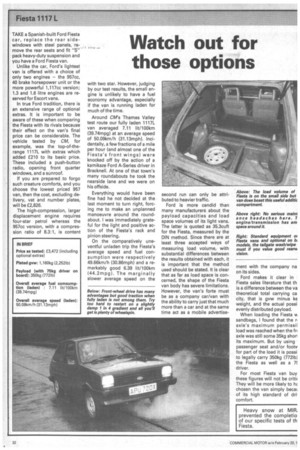Watch out for those options
Page 26

If you've noticed an error in this article please click here to report it so we can fix it.
TAKE a Spanish-built Ford Fiesta car, replace the rear sidewindows with steel panels, remove the rear seats and fit "S" pack heavy-duty suspension and you have a Ford Fiesta van.
Unlike the car, Ford's lightest van is offered with a choice of only two engines — the 957cc, 40 brake horsepower unit or the more powerful 1,117cc version; 1.3 and 1.6 litre engines are reserved for Escort vans.
In true Ford tradition, there is an extensive range of optional extras. It is important to be aware of these when comparing the Fiesta with its rivals because their effect on the van's final price can be considerable. The vehicle tested by CM, for example, was the top-of-therange 11171_ with extras which added £210 to its basic price. These included a push-button radio, opening front quarter windows, and a sunroof.
If you are prepared to forgo such creature comforts, and you choose the lowest priced 957 van, then the cost, excluding delivery, vat and number plates, will be £2,826.
The high-compression, larger displacement engine requires four-star petrol whereas the 957cc version, with a compression ratio of 8.3:1, is content with two star. However, judging by our test results, the small engine is unlikely to have a fuel economy advantage, especially if the van is running laden for much of the time.
Around CM's Thames Valley test route our fully laden 11171_ van averaged 7.11 lit/100km (39.74mpg) at an average speed of 50.09km/h (31.13mph). Incidentally, a few fractions of a mile per hour (and almost one of the Fiesta's front wings) were knocked off by the action of a kamikaze Ford A-Series driver in Bracknell. At one of that town's many roundabouts he took the nearside lane and we were on his offside.
Everything would have been fine had he not decided at the last moment to turn right, forcing me to make an unplanned manoeuvre around the roundabout. I was immediately grateful for the light and positive action of the Fiesta's rack and pinion steering.
On the comparatively uneventful unladen trip the Fiesta's average speed and fuel consumption were respectively 49.66km/h (30.86mph) and a remarkably good 6.39 lit/100km (44.2mpg). The marginally slower average speed on the second run can only be attributed to heavier traffic.
Ford is more candid than many manufacturers about the payload capacities and load space volumes of its light vans. The latter is quoted as 35.3cuft for the Fiesta, measured by the DIN method. Since there are at least three accepted ways of measuring load volume, with substantial differences between the results obtained with each, it is important that the method used should be stated. It is clear that as far as load space is concerned, the shape of the Fiesta van body has severe limitations. However, the van's forte must be as a company car/van with the ability to carry just that much more than a car and at the same time act as a mobile advertise ment with the company na on its sides.
Ford makes it clear in Fiesta sales literature that th is a difference between the va theoretical total carrying ca city, that is gvw minus ke weight, and the actual possi evenly distributed payload.
When loading the Fiesta sandbags, 1 found that the n axle's maximum permissil load was reached when the fn axle was still some 35kg short its maximum. But by using passenger seat and/or footv for part of the load it is possi to legally carry 350kg (7721b) the Fiesta as well as a 7E driver.
For most Fiesta van buy these figures will not be critic They will be more likely to hi. chosen the van simply becat of its high standard of dri' comfort.


















































